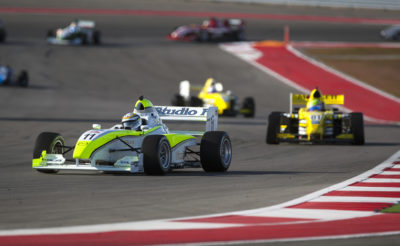The spec formula idea has been around almost as long as the formula car – a single-make chassis with only one engine choice, often built and sealed by a single supplier. It’s an especially successful concept when that spec car is built around a reliable Mazda rotary engine.
The Pro Mazda Championship’s beginnings date back to 1983, when the Formula Russell was built for the Jim Russell School by Hayashi in Japan and featured a Mazda rotary engine. In 1990, Star Race Cars started building the Star Formula Mazda and, a year later, principal Gary Rodrigues created a series for the car. That series continued for 13 years with the original tubeframe chassis until the new, carbon composite monocoque chassis with the 250hp Mazda Renesis rotary engine was introduced for the pro series in 2004.
The championship survived that way for nine years, outlasting the Atlantic Championship, until Rodrigues announced it would fold at the end of 2012. The economy had taken its toll, and it appeared the fastest Mazda-powered part of the Mazda Road to Indy ladder was about to fade into the sunset. Fortunately, the series had a rescuer in Dan Andersen, already operating the successful U.S. F2000 Championship.
“I owned a team in the Pro Mazda Series for six or seven seasons so I’m very familiar with it,” Andersen says. “I think it’s an essential part of the Mazda Road to Indy ladder, which is three steps starting with my U.S. F2000 Championship, Pro Mazda being second and Indy Lights being the final step before a driver moves up to IndyCar.” Next year, Andersen will take over running the Indy Lights Championship as well.
The series has produced some notable drivers over the years, such as Joey Hand, Raphael Matos, Joel Miller, Graham Rahal, Conor Daly, Tristan Vautier and Jack Hawksworth. Now, with Andersen holding the reigns, it appears its future of producing star drivers at the top levels of U.S. auto racing is secure. Andersen is making some alterations to make sure it stays that way.
“We’ve made two significant changes to the championship. We changed to a more durable, cost-effective tire, moving from Goodyear to Cooper. With Mazda’s assistance, John Doonan particularly, we changed the engine rebuilding program to SpeedSource, Mazda’s partner in sports car racing. That’s significant, because prior to SpeedSource, the engines would last three races; now they last more than a season. That is a significant cost reduction to our teams.”
At most events other than the ovals, of which there are two, the series runs double races, which allows the teams and drivers to have a 16-race season in nine weekends, reducing travel costs. After 14 races in 2013, with only the double on the Houston street circuit remaining, Matthew Brabham has already clinched the championship and earned the scholarship to race in Indy Lights in 2014.


 ACCESSIBILITY
ACCESSIBILITY